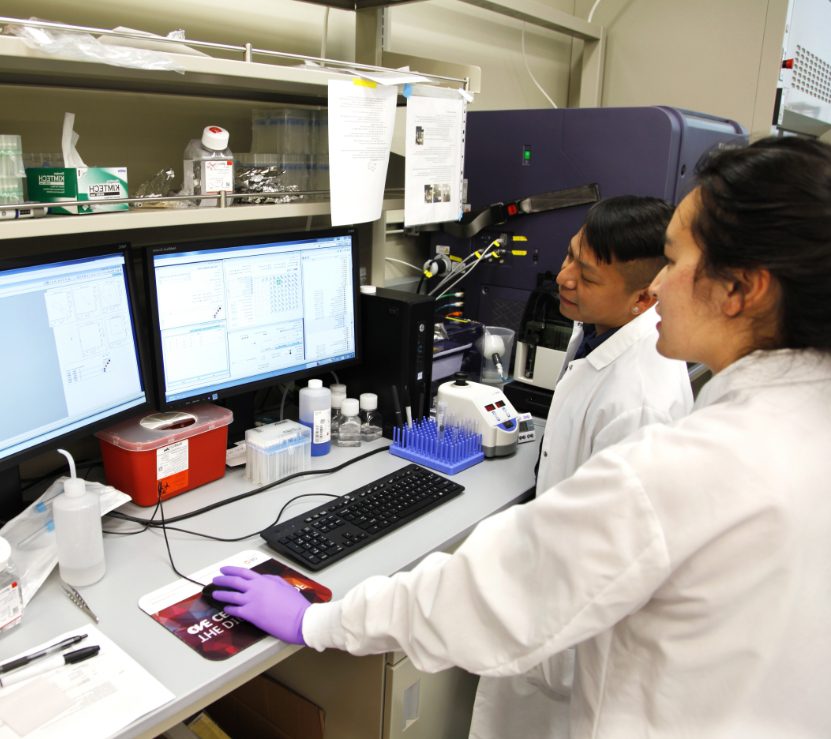
The night before the start of the 2018 J.P. Morgan HealthCare Conference, TRexBio CEO Johnston Erwin recalled, he was sitting around a small table having a cocktail napkin discussion with Houman Ashrafian, DPhil, of SV Health Investors, and Michael D. Rosenblum, MD, PhD, of University of California, San Francisco.
Months earlier, Rosenblum and colleagues had published a paper in Cell showing how a population of regulatory T cells (Tregs) in skin localized to hair follicles played a major role in their biology by promoting the function of hair follicle skin stem cells. The Tregs not only communicated with the immune system in the skin, but also directly with the tissue-resident stem cells, controlling not only tissue inflammation but also tissue repair mechanisms.
“We were talking about how this was a brilliant idea and that we could form a company around this,” Erwin said.
Erwin at the time led Eli Lilly’s internal venture capital investment team Lilly New Ventures, which with SV were among early investors in the company, formed as Singularity before changing its name to TRexBio—a take-off on the Tregs upon which the company focuses.
On January 6, TRexBio launched its second collaboration with a biopharma giant, inking a multi-year research collaboration and licensing agreement with Janssen Pharmaceutica NV, part of Johnson & Johnson. The companies have agreed to use TRexBio’s platform to discover novel targets that address unmet needs in TRex’s core therapeutic area of immunology and inflammation (I&I).
TRexBio’s platform, dubbed Deep Biology, helps identify and characterize novel targets by mapping human tissue Treg behavior to disease processes. As key regulators of the immune system, Tregs play important roles in tissue inflammation and mediation of tissue healing.
Deep Biology has identified more than 20 novel tissue-focused targets so far. The platform has three pillars. One is the TRex Treg Atlas, through which the company has built a high-resolution map of tissue Treg pathways in health and disease, using sequencing and computational methods, and has applied what it gleans from that map to identify novel targets for therapeutics aimed at modulating cells directly in the diseased tissue.
Another pillar, computational tools, help TRexBio generate an in silico hypothesis by evaluating the catalog of gene expression to identify key tissue regulation pathways. The platform’s third pillar is a suite of functional assays in human primary Tregs or “Assay Cascade” that rapidly screens multiple targets and donors concurrently, in order to reveal clinically relevant biology for therapeutic intervention.
“To whom are these cells talking?”

“We’ve mastered human tissue collection first, and then we’ve applied modern sequencing and computational tools to identify these pathways and map them to disease states,” explained Melanie Kleinschek, DVM, PhD, TRegBio’s chief scientific officer. “We’re using bulk and single cell RNA sequencing to really get the breadth and the depth of the tissue Treg transcriptome. We’re characterizing them amidst all the other cells in the tissue, so that we can really analyze the interactome as well: To whom are those cells talking?”
“That’s really the core to our database that we’re building. We’re layering on now other ‘omics approaches to get a little bit more of a deeper, even deepest understanding of how those cells operate,” Kleinschek said. “With that sort of a strong in silico hypothesis, based on human tissue data and a functional characterization, we think we have a translational understanding of any new pathway that we find to build out our pipeline.”
The Treg atlas recreates human tissue-specific pathways for validation in the TRex Assay Cascade—including approximately 1,000 tissue Treg-enriched genes, of which 70% are captured through the reprogramming of blood Tregs.
TRexBio is among companies focusing their drug development efforts on targeting Tregs. Last year, Merck & Co. shelled out $1.85 billion to acquire Pandion Pharmaceuticals, whose pipeline focused on Treg-targeting treatments for autoimmune disorders.
Pandion’s lead candidate, the ulcerative colitis therapy PT101 (now Merck’s MK-6194) is an engineered IL-2 mutein fused to a protein backbone designed to selectively activate and expand regulatory T cells for the treatment of autoimmune diseases. A year ago, Pandion announced the drug had shown proof of mechanism in a 56-patient Phase Ia trial, selectively expanding Tregs with a mean maximal increase up to of 3.6-fold over baseline, and more than 70-fold over baseline for a subset of activated Tregs with high CD25 expression.
In August 2021, GentiBio raised $157 million in Series A financing toward developing engineered regulatory T cell therapies designed to functionally cure autoimmune, alloimmune, autoinflammatory, and allergic diseases. Matrix Capital Management led the financing with participation by Avidity Partners, JDRF T1D Fund, and seed investors OrbiMed, RA Capital Management, and Novartis Venture Fund, and Seattle Children’s Research Institute. GentiBio launched a year earlier with $20 million in seed financing.
Today the Treg space is dominated by cell therapy and IL-2 based drugs, and IL-2 modifications via protein engineering approaches. According to Kleinschek, “instead of using the cells as a therapy, we are developing a deep understanding of those cells to identify novel targets to modulate them with traditional pharmacological approaches.”
“Those go beyond just the IL-2 pathway,” Kleinschek added. “We believe that this approach really has many applications in sustaining our own pipeline.”
Pipeline focus on I&I
TRexBio plans to keep that pipeline focused on I&I. “Our focus as a company is in the immunology and inflammation space, and we think that that is broad enough,” says Laura Berner, JD, TRexBio’s Chief Business Officer. “There are probably other areas that the platform could be useful in, but we think that’s the highest value.”
Berner said TRexBio and Janssen took about a year from their first meeting to hammer out their collaboration. It helped that Johnson & Johnson Innovation—a J&J umbrella for entities created to support collaborations with early-stage partners—was an early investor in TRexBio, although it was not a deciding factor in the partnership being launched, she said.
The Janssen collaboration has some similarities with TRexBio’s first collaboration with a biopharma giant. TRexBio has partnered with Lilly to develop four of TRex’s seven pipeline candidates in various preclinical phases: TRB-031, TRB-041, TRB-051, and TRB-052. All four are being developed for undisclosed I&I indications, as are two other candidates, TRB-061 and TRB-000. [The seventh candidate, TRB-012, is being developed for an oncology indication].
The collaboration with Lilly is progressing. “We’ve been working with them closely for a number of years now. At this stage, they’ve selected their targets, and we’re really progressing programs with them,” Berner said. “Lilly was a cornerstone investor, and they were one of the early believers and really helped us validate the platform. And we’re really pleased that that J&J/Janssen further validated the platform by expressing their interest.”
To help with the Janssen collaboration and address other company needs, TRexBio plans to grow its workforce this year from more than 30 people at present to about 40, Erwin said.
While most of TRexBio’s workforce is based at the company’s headquarters in South San Francisco, some staffers are working virtually from Indianapolis, San Diego, Colorado, and Boston.
TRexBio also plans to advance “two or three” candidates from its seven preclinical therapeutic programs for development this year, with an eye toward bringing them into the clinic in 2023.
Pulling the pieces together
TRexBio has come a long way from the cocktail napkin meeting in 2018. It was Ashrafian—a Managing Director at SV Health Investors and Head, Experimental Therapeutics and Clinical Pharmacology at Oxford University –who got the ball rolling to launch the company, based on the research of Rosenblum, Vice Chair of Research and a professor at UCSF’s Department of Dermatology, and a co-founder of Delinia Therapeutics, which was acquired in 2017 by Celgene (since acquired by Bristol Myers Squibb).
Rosenblum’s lab focuses on understanding how immune responses are regulated in tissues and how that knowledge can be applied for therapeutic benefit. His lab at UCSF handles tissue prep and sequencing for skin samples studied by TRexBio.
The company also works with another researcher—Alison Simmons, MD, PhD, director of the MRC Human Immunology Unit and a professor of gastroenterology at Oxford University—in a collaboration studying Treg biology in gut and lung tissue.
“Houman networked with Mike, networked with Lilly executives, including myself at the time. He networked about an opportunity of where to create lab space. South San Francisco came to mind, as that’s also proximal to Mike’s lab, which is not far from us,” Erwin said. “Houman led the initial part of pulling all those pieces together.”
Erwin joined TRexBio as CEO in May 2021 after retiring from Lilly, where he’d spent 36 years. A month later, TRexBio emerged from stealth mode by announcing it closed the final tranche of its $59 million Series A financing. Joining J&J Innovation, Lilly, and SV Health as investors were two other big names, Pfizer and Alexandria Venture Investments, the strategic venture capital platform of Alexandria Real Estate Equities.
Also in June 2021, TRexBio announced the appointments of Erwin and Ovid Trifan, MD, PhD, as chief medical officer. Trifan joined the company from Apexigen, where he was CMO and senior VP of Development.
From 2014 until his retirement, Erwin led Lilly’s VC arm as Vice President, Corporate Business Development–Lilly New Ventures. Previously, he led the clinical team which oversaw J&J’s global regulatory submissions for osteoporosis drugs Forteo® (teriparatide injection) and Evista® (raloxifene), which also carries indications in breast cancer.
“I was really interested in the science and the direction of TRexBio, and the management team that was at the company that I’d be working with. It all came down to the science and the people,” Erwin said. “With our collaboration and one of our larger shareholders being Lilly, I still have an opportunity, although I’m retired, to work with a number of colleagues and close friends.”

